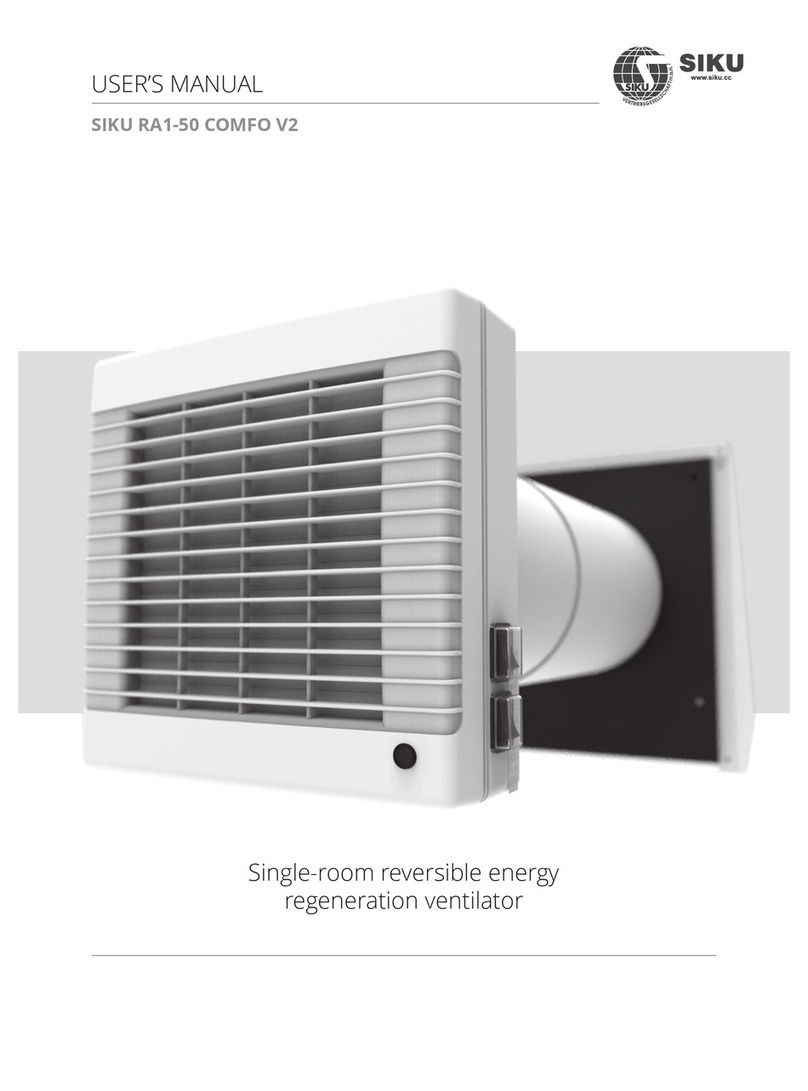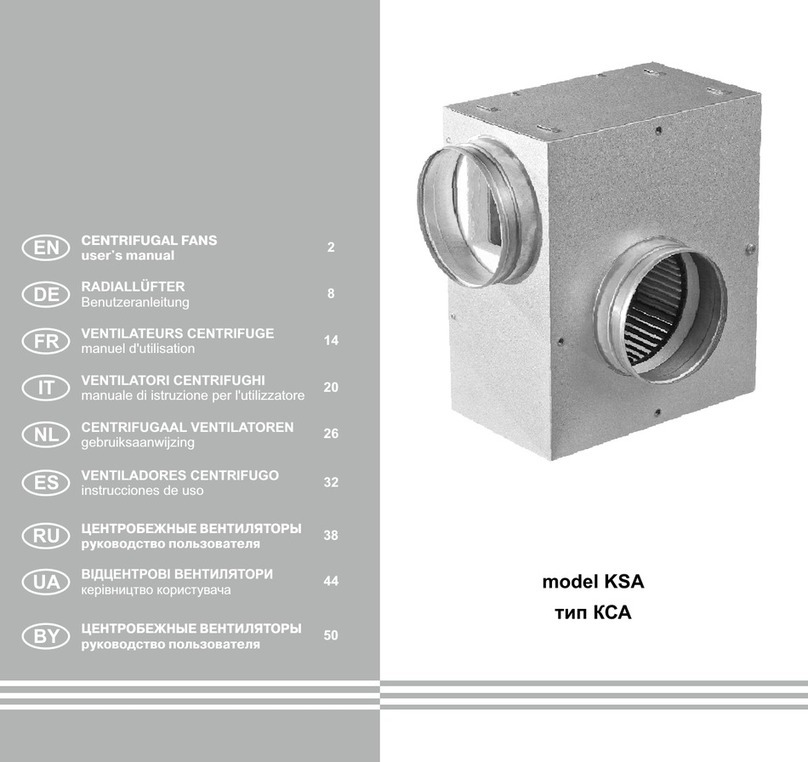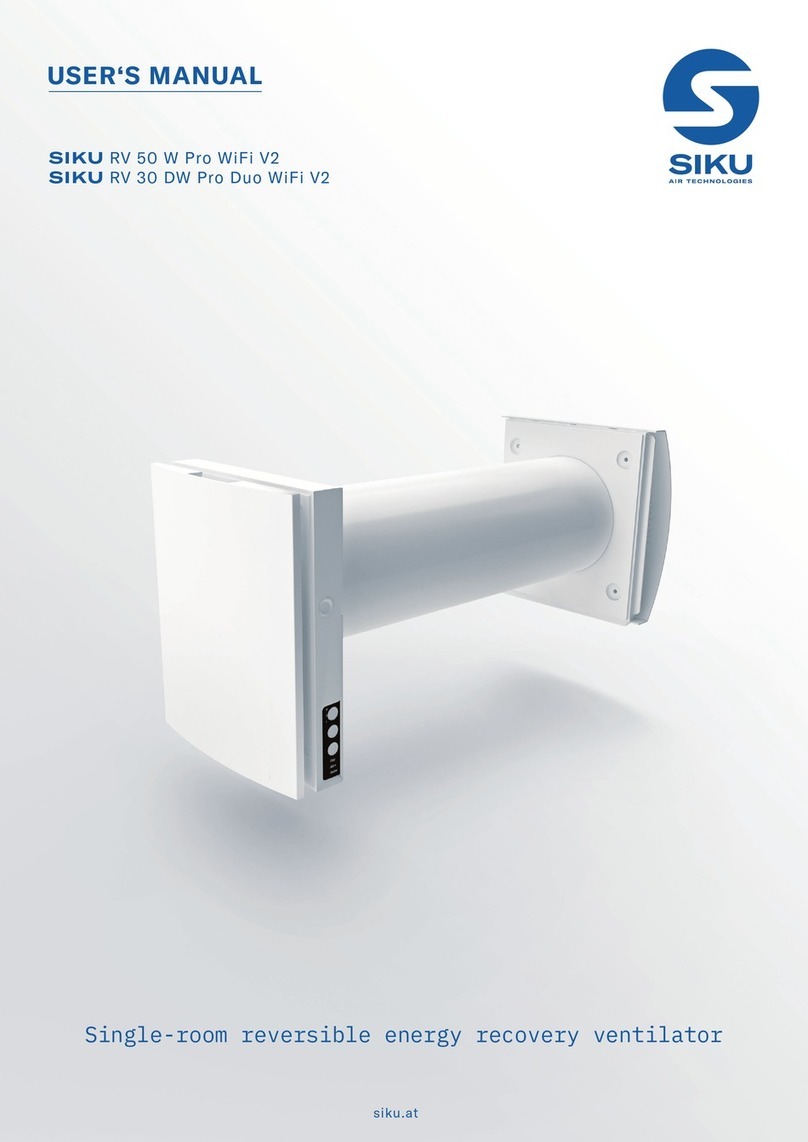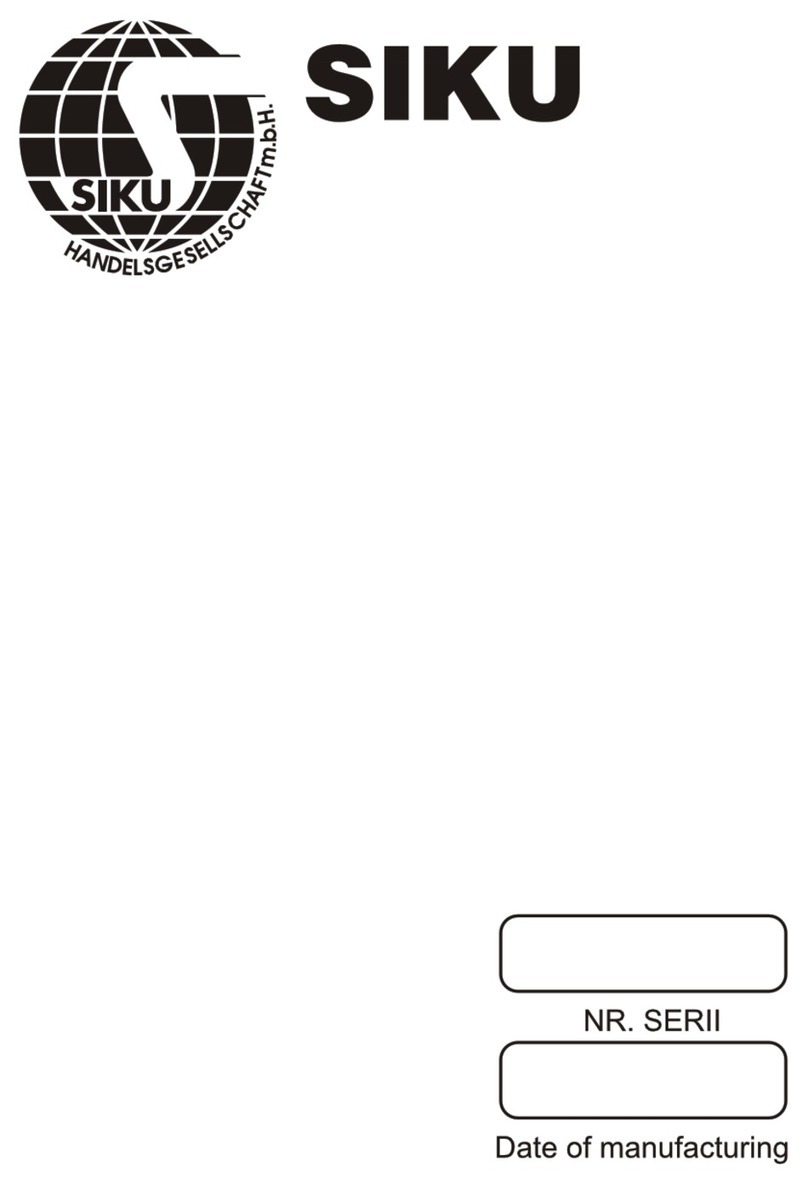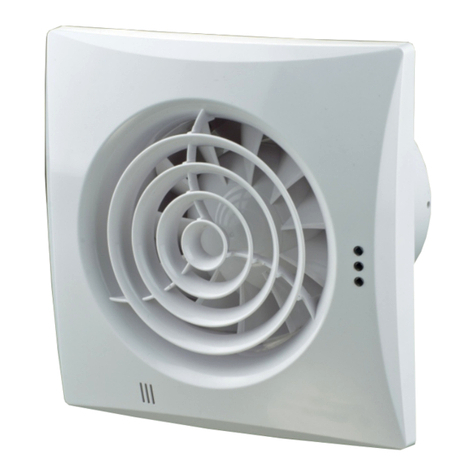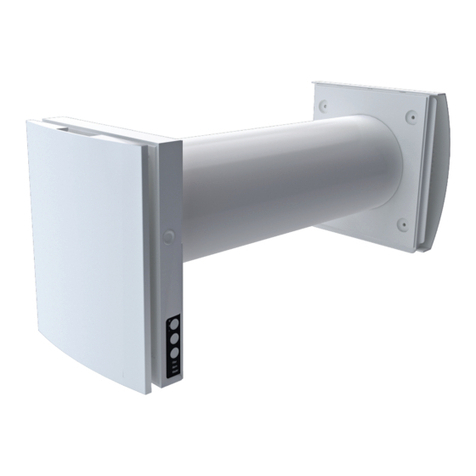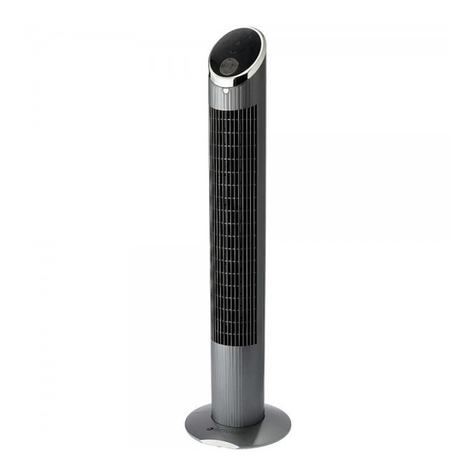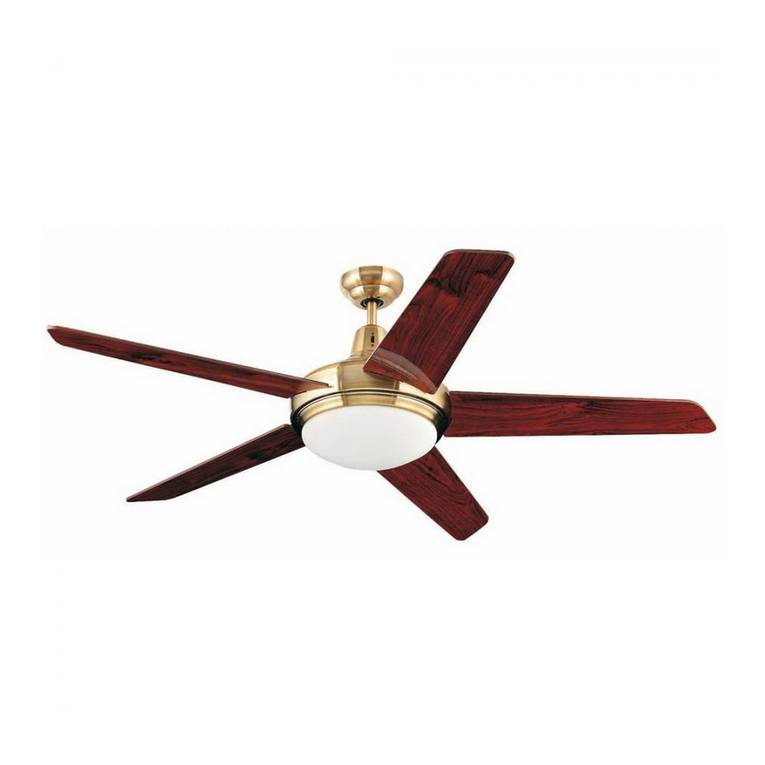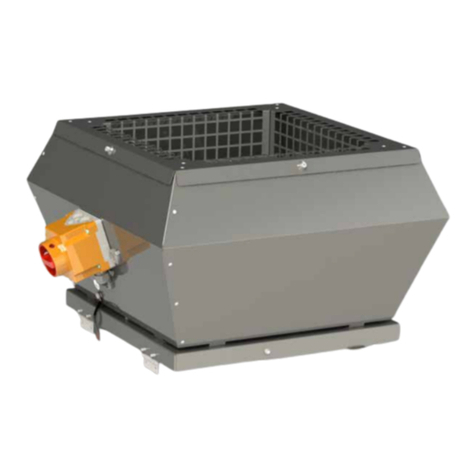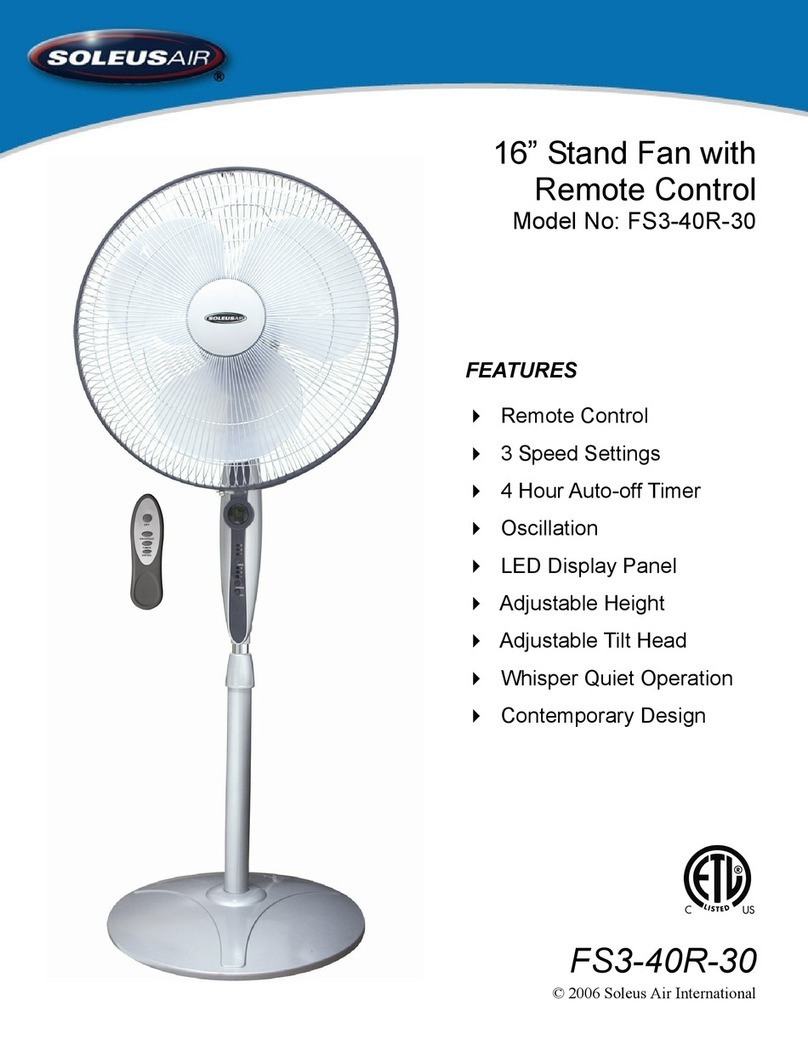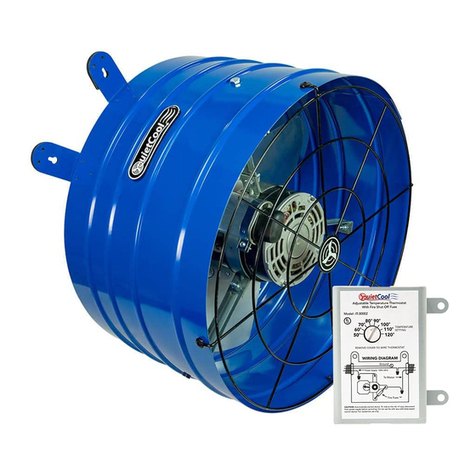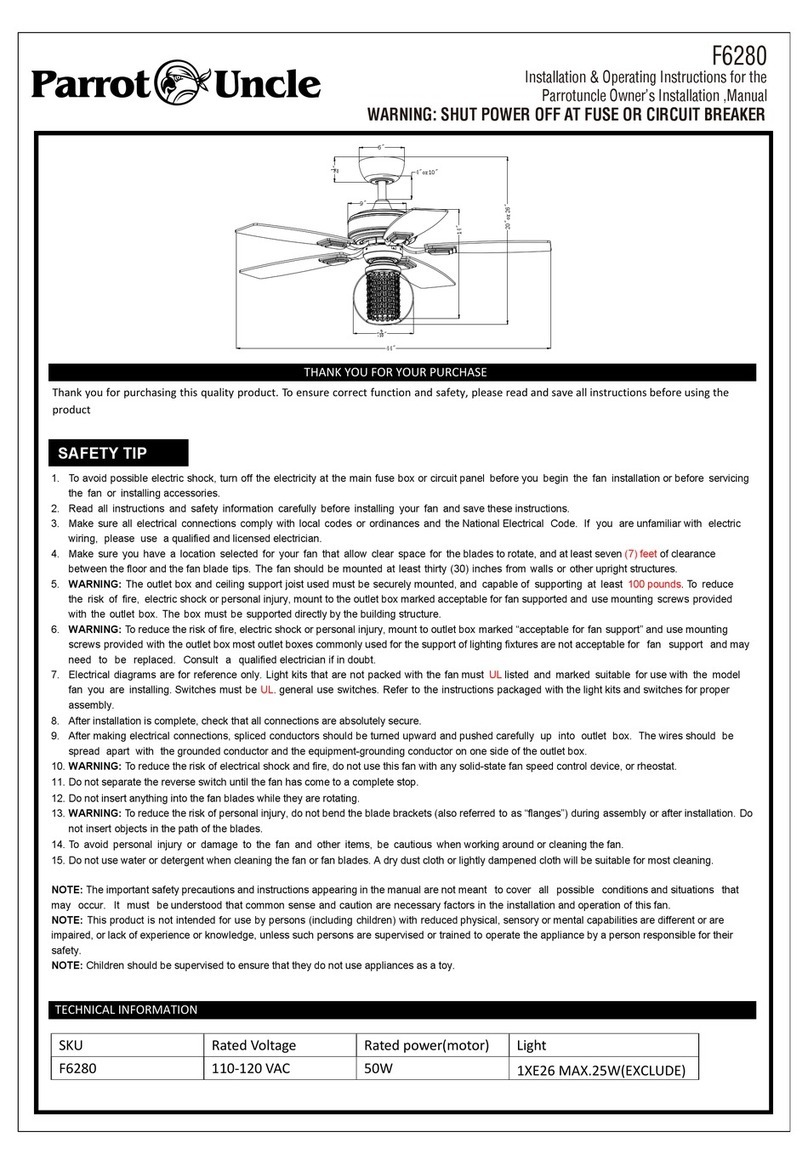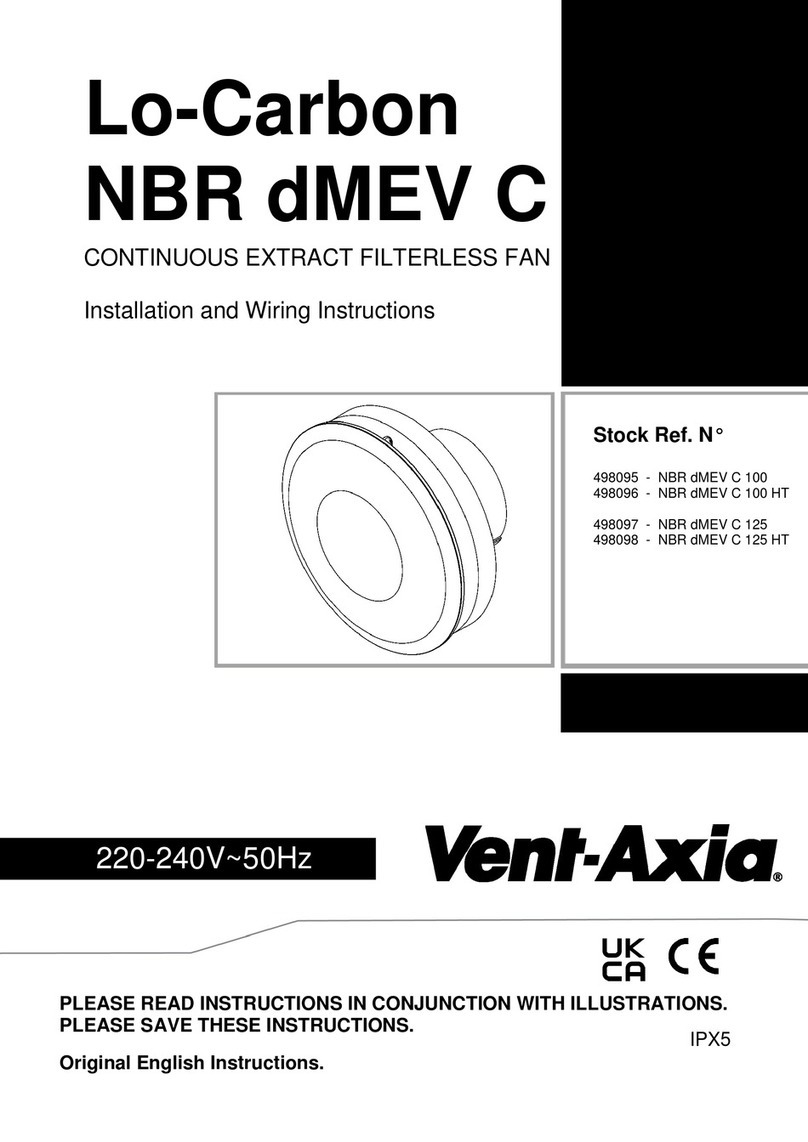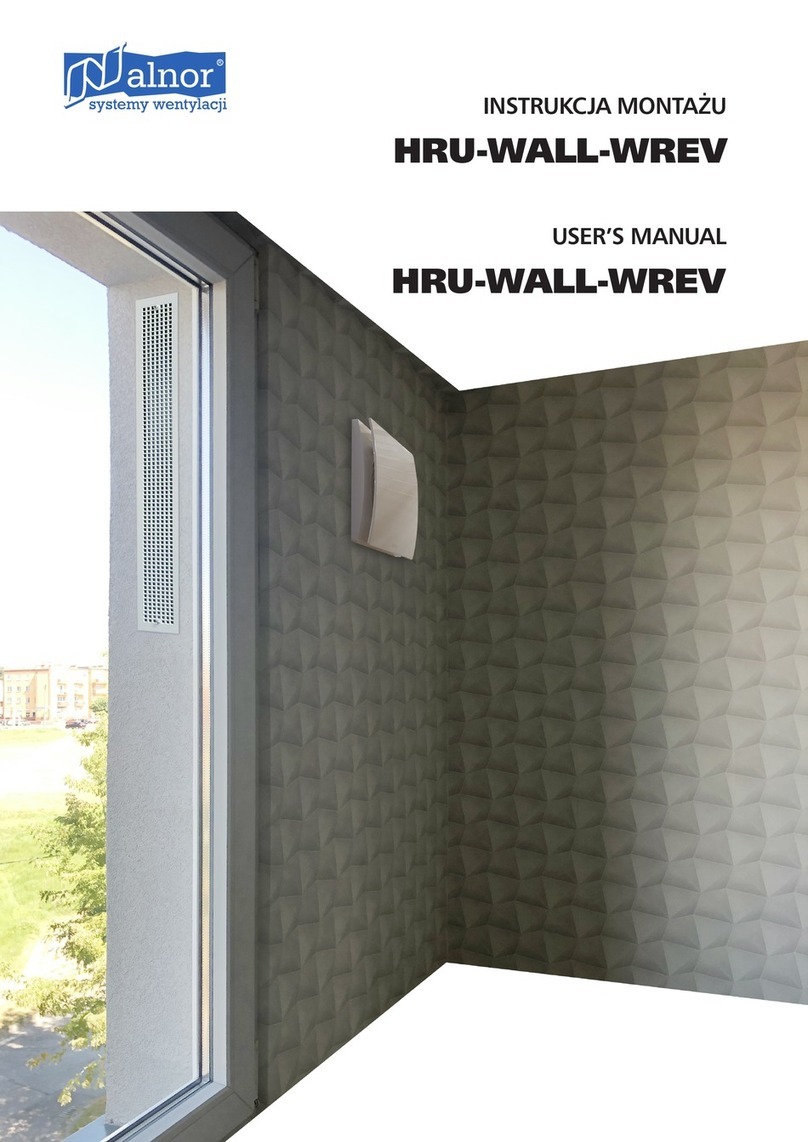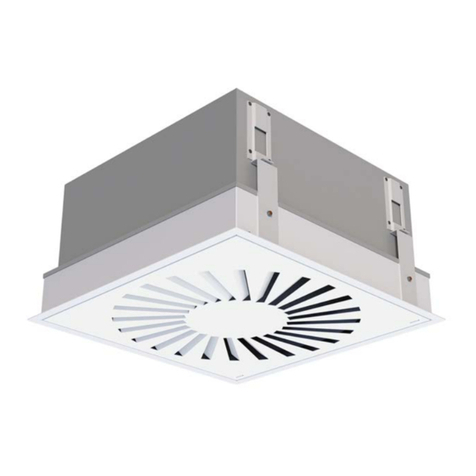Siku RV 25 W Pro WiFi V2 User manual

Single-room reversible energy regeneration ventilator
USER'S MANUAL
SIKU RV 25 W Pro WiFi V2

2
SIKU RV 25 W Pro WiFi V2
www.siku.cc
CONTENTS
This user’s manual is a main operating document intended for technical, maintenance, and operating staff. The manual contains
information about purpose, technical details, operating principle, design, and installation of the SIKU RV 25 W Pro WiFi V2 unit and all its
modifications.
Technical and maintenance staff must have theoretical and practical training in the field of ventilation systems and should be able to
perform works in accordance with workplace safety rules as well as construction norms and standards applicable in the territory of the
country.
The information in this user’s manual is correct at the time of the document’s preparation.
The Company reserves the right to modify the technical characteristics, design, or configuration of its products at any time in order to
incorporate the latest technological developments.
No part of this publication may be reproduced, stored in a retrieval system, or transmitted, in any form or by any means in any information
search system or translated into any language in any form without the prior written permission of the Company.
SAFETY REQUIREMENTS
• Please read the user’s manual carefully prior to installing and operating the unit.
• All user’s manual requirements as well as the provisions of all the applicable local and national construction, electrical, and technical
norms and standards must be observed when installing and operating the unit.
• The warnings contained in the user’s manual must be considered most seriously since they contain vital personal safety information.
• Failure to follow the rules and safety precautions noted in this user’s manual may result in an injury or unit damage.
• After a careful reading of the manual, keep it for the entire service life of the unit.
• While transferring the unit control, the user’s manual must be turned over to the receiving operator.
UNIT INSTALLATION AND OPERATION SAFETY PRECAUTIONS
• Disconnect the unit from power mains prior
to any installation operations. • Unpack the unit with care.
• The unit must be grounded!
• While installing the unit, follow the safety
regulations specific to the use of electric
tools.
Safety requirements..................................................................................................................................................................... 2
Purpose................................................................................................................................................................................................ 4
Delivery set........................................................................................................................................................................................ 4
Designation key.............................................................................................................................................................................. 4
Technical data.................................................................................................................................................................................. 5
Unit design and operating principle................................................................................................................................. 6
Installation and set-up................................................................................................................................................................ 7
Connection to power mains and control....................................................................................................................... 10
Technical maintenance.............................................................................................................................................................. 21
Troubleshooting............................................................................................................................................................................. 22
Storage and transportation regulations.......................................................................................................................... 22
Manufacturer’s warranty........................................................................................................................................................... 23
Certificate of acceptance.......................................................................................................................................................... 27
Seller information.......................................................................................................................................................................... 27
Installation certificate.................................................................................................................................................................. 27

3
www.siku.cc
SIKU RV 25 W Pro WiFi V2
• Do not change the power cable length at
your own discretion. Do not bend the power
cable. Avoid damaging the power cable. Do
not put any foreign objects on the power
cable.
• Do not lay the power cable of the unit in
close proximity to heating equipment.
• Do not use damaged equipment or cables
when connecting the unit to power mains.
• Do not operate the unit outside the
temperature range stated in the user’s
manual. Do not operate the unit in
aggressive or explosive environments.
• Do not touch the unit controls with wet
hands. Do not carry out the installation and
maintenance operations with wet hands.
• Do not wash the unit with water. Protect the
electric parts of the unit against ingress of
water.
• Do not allow children to operate the unit. • Disconnect the unit from power mains prior
to any technical maintenance.
• Do not store any explosive or highly
flammable substances in close proximity to
the unit.
• When the unit generates unusual sounds,
odour, or emits smoke, disconnect it from
power supply and contact the Seller.
• Do not open the unit during operation. • Do not direct the air flow produced by the
unit towards open flame or ignition sources.
• Do not block the air duct when the unit is
switched on.
• In case of continuous operation of the unit,
periodically check the security of mounting.
• Do not sit on the unit and avoid placing
foreign objects on it. • Use the unit only for its intended purpose.
THE PRODUCT MUST BE DISPOSED SEPARATELY AT THE END OF ITS SERVICE LIFE.
DO NOT DISPOSE THE UNIT AS UNSORTED DOMESTIC WASTE.

4
SIKU RV 25 W Pro WiFi V2
www.siku.cc
PURPOSE
The ventilator is designed to ensure continuous mechanical air exchange in flats, cottages, hotels, cafés and other domestic and public
premises.The ventilator is equipped with a regenerator that enables supply of fresh filtered air heated by means of extract air heat energy
recovery. The ventilator is designed for wall flush mounting.
The unit is rated for continuous operation.
THE UNIT SHOULD NOT BE OPERATED BY CHILDREN OR PERSONS WITH REDUCED
PHYSICAL, MENTAL, OR SENSORY CAPACITIES, OR THOSE WITHOUT
THE APPROPRIATE TRAINING.
THE UNIT MUST BE INSTALLED AND CONNECTED ONLY BY PROPERLY QUALIFIED
PERSONNEL AFTER THE APPROPRIATE BRIEFING.
THE CHOICE OF UNIT INSTALLATION LOCATION MUST PREVENT UNAUTHORIZED
ACCESS BY UNATTENDED CHILDREN.
Transported air must not contain any flammable or explosive mixtures, evaporation of chemicals, sticky substances, fibrous materials,
coarse dust, soot and oil particles or environments favourable for the formation of hazardous substances (toxic substances, dust,
pathogenic germs).
DELIVERY SET
Name Quantity
Indoor unit 1 pc.
Air duct 1 pc.
Sound absorbing mat 1 pc.
Assembled cartridge 1 pc.
Outer ventilation hood 1 pc.
Cardboard mounting template 2 pc.
Fastening kit 2 sets
Polystyrene wedges 1 set
User's manual 1 pc.
Installation instruction for the ventilation hood 1 pc.
Packing box 1 pc.

5
www.siku.cc
SIKU RV 25 W Pro WiFi V2
TECHNISCHE DATEN
The unit is designed for indoor application at outdoor air temperatures from -15 ˚C (5 °F) up to +40°C (104 °F) and relative indoor humidity
up to 50 %.
The unit has Class II of protection against electric shock and must not be grounded.
Hazardous parts access and water ingress protection rating is IP24.
The unit design is constantly being improved, so some models may be slightly different from those ones described in this manual.
TECHNICAL DATA
Speed I II III
Power supply voltage 50 (60) Hz [V] 1~100-240
Power consumption [W] 1.8 3.0 4.40
Current consumption [A] 0.027 0.037 0.051
Max. air flow [m3/h] (CFM) 10 (6) 20 (12) 30 (18)
Filters G3 (MERV 7);
Sound pressure level @ 1 m [dBA(Sones)] 30 (1.1) 37 (2.0) 40 (2.5)
Sound pressure level @ 3 m [dBA(Sones)] 21 (0.4) 28 (0.9) 31 (1.1)
Outdoor noise level attenuation [dBA (Sones)] 42 (2.5)
IP rating IP24
WIFI TECHNICAL DATA
Standard IEEE 802.11 b/g/n
Frequency band [GHz] 2.4
Transmission power [mW] (dBm) 100 (+20)
Power mains DHCP
WLAN safety WPA. WPA2
The air duct length depends on the ventilator model, refer to the Designation
Key, page 4.
The supplied ventilation hood model depends on the ventilator model.
The distance A is 0-10 mm.
The overall dimensions of the front panel are stated below.
OVERALL DIMENSIONS OF THE INDOOR UNIT MM
ø106,6
A
ø102,6
Außenhaube
Außenabdeckung
Länge des Lüftungsrohres
39 55
140
175
222
123
189
Outer
ventilation
hood
Air duct length
Front panel

6
SIKU RV 25 W Pro WiFi V2
www.siku.cc
UNIT DESIGN AND OPERATING PRINCIPLE
The ventilator consists of an indoor unit with a decorative front panel, a cartridge, an air duct with a sound absorbing mat and an outer
ventilation hood.
Cartridge is the basic functioning part of the ventilator. The cartridge consists of a fan, a regenerator and two filters that ensure rough air
filtration and prevent ingress of dust and foreign objects into the regenerator and the fan.
The indoor unit is equipped with an automatic air damper that closes during shutdown of the ventilator and prevents air backdraft.
VENTILATOR DESIGN
VENTILATOR OPERATION MODES
The ventilator has three operation modes:
Ventilation: the ventilator runs either in extract or supply mode at a set speed.
Air supply (available from a mobile device only): all the connected ventilators in the network go to the air supply mode.
Regeneration: the ventilator runs in the reversible mode with heat and humidity recovery.
In the Regeneration mode the ventilator operates in two cycles.
Cycle I. Warm stale extract air flows through the ceramic regenerator and heats it up and moisturizes the regenerator.
Cycle II. Fresh and cold intake air from outside flows through the ceramic regenerator, absorbs accumulated moisture and get heated up
to the room temperature with the heat accumulated in the heat exchanger.
Patrone
Einheit bestehend aus einem Ventilator, einem Wärmetauscher und
Filtern. Erzeugt den Luftstrom und sorgt für die
Wärmerückgewinnung und Luftfiltration.
Teleskop-Lüftungsrohr
Kunststoff-Luftleitung.
Außenabdeckung des Innenelementes
Mit einer automatischen Luftklappe versehen,
die das Lüftungsrohr bei Abschalten der Lüftungsanlage schließt.
Rückseite des Innenelementes
Die Einheit umfasst
eine Steuerplatine und Sensor-Tasten.
Montagerahmen
Erleichtert die Montage der Lüftungsanlage in der dünnen
Wänden mit einer Dicke ab 135 mm.
Außenhaube
Schützt die Lüftungsanlage gegen Eindringen von
Wasser und Fremdkörpern von außen. Zu jedem Modell der
Lüftungsanlage gibt es eine passende Außenhaube.
Outer ventilation hood
Protects the unit from ingress of water and foreign objects.
Each ventilator model has a matching ventilation hood model.
Mounting frame
Facilitates mounting of the ventilator in thin walls with the
thickness from 135 mm.
Telescopic air duct
Plastic air duct.
Cartridge
Assembly unit consisting of a fan, a regenerator and air filters.
Generates air flow, provides energy regeneration and air cleaning.
Indoor unit front panel
Equipped with an automatic air damper that closes up the air duct at
the ventilator power off.
Indoor unit rear side
The unit includes a circuit control board
and touch buttons.

7
www.siku.cc
SIKU RV 25 W Pro WiFi V2
FUNCTIONING OF AUTOMATIC AIR DAMPER
The indoor unit has a front panel with automatic air damper. During the
ventilator operation the air damper opens to let the air flow through
the ventilator.
The air damper closes within 2 minutes after power off of the ventilator.
INSTALLATION AND SETUP
READ THE USER'S MANUAL BEFORE INSTALLING THE UNIT.
DO NOT BLOCK THE AIR DUCT OF THE INSTALLED VENTILATOR WITH DUST
ACCUMULATING MATERIALS, SUCH AS CURTAINS, CLOTH SHUTTERS, ETC.
AS IT PREVENTS AIR CIRCULATION IN THE ROOM.
1. Prepare a round core hole in the outer wall. The hole size is shown in the figure below.
ø 120
ø 4 3/4"
min 500
min 19 11/16"
min 500
min 19 11/16"
min 500
min 19 11/16"
A
A
A-A
2. Insert the air duct in the wall hole. For ease of installation use the polystyrene wedges included in the delivery set. The air duct end must
protrude for the distance A that enables installation of the outer ventilation hood. The distance A is 0-10 mm.
A
ø106,6*ø102,6
Polystyrolkeil
Füllen Sie die Hohlräume
zwischen dem Lüftungsrohr und
der Wandöffnung mit
Montageschaum aus.
min 3 mm
Install the air duct with the minimum slope of 3 mm downwards to
the outer wall side.
To cut the air duct either make preliminary calculations of the
required duct length or make sure to have access to the outer wall
after fixation of the air duct.
Die Abdeckung
ist geschlossen
Die Abdeckung ist
geönet
Fill the gaps between the
air duct and the hole with
mounting foam.
Polystyrene wedge
The cover is
closed
The cover is
open

8
SIKU RV 25 W Pro WiFi V2
www.siku.cc
3. Take the required mounting template and then fasten it to the indoor wall using the adhesive tape. The large opening in the template
must be coaxial with the air duct. For aligning the template with respect to the horizon line it is recommended to use a builder’s level.
Then mark the fastening holes for installation of the supplied dowels and drill the holes to a required depth.
Route the power cable of the ventilator from the wall through the marked opening on the template.
220
160
140
55
Ø10
Ø5
Ø120
188
50
123
220
160
124.3
55
Ø10
Ø120
140
123
36
Ø5
Schablone zur Montage der
Rückseite des Innenelements
Schablone zur Montage
des Montagerahmens
4. Pull the lug on the bottom to disconnect the front panel of the indoor unit from the rear part. Attach the mounting frame on the wall
if you use it.
Fix the rear part of the indoor unit on the wall or on the mounting frame using the screws supplied with the mounting kit of the ventilator.
5. Remove the two screws that retain the terminal cover to enable access to the connection terminals.
Route the power cable as figured below and connect the ventilator to power mains in compliance with the external wiring diagram, see
page 10.
Fix the power cable and the control cables with a cable clamp. After completion of the electrical connection re-install the transparent
terminal cover in site.
Mounting template for installation
of the rear part of the indoor unit
Mounting template for installation
of the mounting frame

9
www.siku.cc
SIKU RV 25 W Pro WiFi V2
7. Insert the cartridge into the air duct and insert the plug cartridge to the controller. Re-install the front panel of the indoor unit rear part.

10
SIKU RV 25 W Pro WiFi V2
www.siku.cc
CONNECTION TO POWER MAINS AND CONTROL
POWER OFF THE POWER SUPPLY PRIOR TO ANY OPERATIONS WITH THE UNIT.
THE UNIT MUST BE CONNECTED TO POWER SUPPLY BY A QUALIFIED ELECTRICIAN.
THE RATED ELECTRICAL PARAMETERS OF THE UNIT ARE GIVEN ON THE
MANUFACTURER’S LABEL.
ANY TAMPERING WITH THE INTERNAL CONNECTIONS IS PROHIBITED
AND WILL VOID THE WARRANTY.
The ventilator is rated for connection to single-phase
AC 100 - 240 V / 50 (60) Hz power mains. The installation of power
cables is described in the Installation and set-up section.
Connect the unit to power mains uing durable, insulated and heat-
resistant conductors (cables and wires). The total minimum cross
section for the power cable must be 0.5 up to 0.75 mm2. The actual
wire cross section selection must be based on the maximum load
current, maximum conductor temperature depending in the wire type,
insulation, length and installation method.
Use copper wires for all the electric connections!
Connect the unit to power mains via the terminal block in compliance
with the wiring diagram and terminal designation. Connect the
ventilator to power supply through an automatic circuit breaker with
electromagnetic trip integrated into the home wiring system. The
rated trip current of the automatic circuit breaker or the safety fuses
must exceed the maximum current consumption of the unit, refer to
the Technical data section.
The recommended trip current of the circuit breaker or safety fuse is the
next current in the standard trip current row following the maximum
current of the connected unit.
WIRING DIAGRAM
QF SLT(1)
L(2)
N(3)
L
N
1~100-240 V
50 (60) Hz
LT: Stromkreis zur Aktivierung des Betriebs Boost
Klemmenmarkierung auf dem
Anschlussschema:
L: Phasenleiter
N: Neutralleiter
QF: Leitungsschutzschalter
S: externer Relaissensor (Relais zur Aktivierung des Betriebs Boost).
To reset the ventilator to the factory settings keep the reset button under the
front panel pressed for 5 seconds till a long beep. Reset to the factory settings
is also possible via the mobile application.
VENTILATOR SETUP
Prior to operating the ventilator set it up using the DIP switch. It is located on
the controller circuit board.
To access the DIP switch take off the front panel of the indoor unit.
ON DIP
1234
USB-Schnittstelle
Taste zum Zurücksetzen
auf Werkseinstellungen
Öffnungssensor der
Abdeckung
Dip-Schalter
LT: circuit for activation of Boost mode
L: line
N: neutral
QF: circuit breaker
S: external relay sensor (switch for activation of Boost mode).
Terminal designation on
the wiring diagram:
DIP switch
Reset to factory settings
button
Cover opening sensor
USB socket

11
www.siku.cc
SIKU RV 25 W Pro WiFi V2
VENTILATOR CONTROL
The ventilator is operated with the following controls:
• the buttons located on the side of the indoor unit (see the figure below)
• the mobile application "SIKU RV WIFI" installed on a smartphone or a tablet
• The Smart home application. The ventilators must be connected to the Smart home application in compliance with user’s manual
for this application.
Lüftung
Die Lüftungsanlage läuft in Zu- oder Abluftbetrieb
in der eingestellten Lüftungsstufe.
Ein/Aus
Lüftungsstufe
Die Einstellung der Lüftungsstufe erfolgt zyklisch:
niedrig-mittel-hoch.
Wärmerückgewinnung
Die Lüftungsanlage läuft im Reversbetrieb mit
Wärme- und Feuchterückgewinnung.
POSITIONING OF THE DIP SWITCH
Setup of ventilator operation mode
1
OFF: Master unit.
1
ON: Slave unit.
Standby mode setup
2
OFF: shutdown of the ventilator in the Standby mode.
2
ON: the ventilator is running at the first speed in the Standby mode.
Ventilation mode setup
3
OFF: the ventilator runs in the extract mode.
3
ON: the ventilator runs in the supply mode.
Programming mode
4
OFF: standard operation mode.
4
ON: programming mode.
Warning! The programming mode can be switched by the service engineers only!
Speed
The speed selection sequence is follows:
low-medium-high.
Regeneration
The ventilator runs in the reversible mode with heat and
humidity recovery.
Ventilation
The ventilator runs in the supply or extract mode with the set
speed.
On/O

12
SIKU RV 25 W Pro WiFi V2
www.siku.cc
VENTILATOR CONTROL WITH THE BUTTONS ON THE INDOOR UNIT
On/Off
The speed selection sequence is follows: low-medium-high.The speed of all the interconnected ventilators in the
network is set with the Master unit.
I: permanent glowing of the indicator indicates running of the ventilator at the low speed.
Blinking of the indicator indicates activation of the timer Night mode.
Iand II: permanent glowing of the indicators I and II indicates running of the ventilator at the medium speed.
I, II and III: permanent glowing of the indicators I, II and III indicates running of the ventilator at the high speed.
Synchronous blinking of the indicators I, II and III indicates activation of the timer in the Party mode or the
turn-off delay timer in the Boost mode in case of triggering of the integrated humidity sensor or the connected
external relay sensor. Alternate blinking of the indicators I, II and III indicates running of the ventilator at the speed
set with the mobile application using the slider selector for manual speed setting or activation of the scheduler.
Regeneration mode
Rotation direction of the fan is changed. Heat regeneration is accomplished in the Regeneration mode. To
enable operation of the ventilators in opposite direction change the position of the DIP switch No. 3.
F
Filter clogging indicator. The indicator starts blinking 90 days after installation of the cartridge. In this case clean
or replace the filters (see the «Technical maintenance» section).
After replacement of the filters reset the filter timer using the mobile application or press and hold the
button on the indoor unit of the Master unit for 5 seconds, until a signal beeps.
A
Alarm indicator. In case of a failure the Alarm indicator on the indoor unit starts to glow or to blink.
Reasons for glowing of the indicator:
• Alarm shutdown of a ventilator caused by another defective ventilator in the network.
Reasons of alarm blinking:
• Battery charge is below the allowable limit
• No connection between the Master unit and the router
• Alarm shutdown of a ventilator. This ventilator causes shutdown of all interconnected ventilators in the
network.
In case of communication loss of the Master unit with the router longer than 20 seconds the Master unit goes
to the Standby mode and the Slave units signal of communication loss with the Master unit. After resumption
of the connection the Slave units automatically get synchronized with the Master unit.
Ventilation mode
The ventilator operates in the supply or extract mode with the set speed. The fan rotation direction depends on
the position of the DIP switch 3.
No glowing of the indicators «Regeneration» and «Ventilation» indicates activated supply ventilation mode of the ventilator..
M
Permanent glowing of the indicator identifies the Master unit in the network.
The blinking Indicator identifies the Slave unit in the network and no connection with the Master unit.
No glowing of the indicator identifies the Slave unit connected with the Master unit.
Synchronous blinking of all the indicators on the ventilator casing indicates the activated Setup mode.

13
www.siku.cc
SIKU RV 25 W Pro WiFi V2
VENTILATOR CONTROL WITH MOBILE APPLICATION
To enable ventilator control with a mobile device install the App SIKU RV WIFI application.
SIKU RV WIFI - App Store SIKU RV WIFI Play Market
Your mobile device must have the operation system matching the following parameters:
• iOS – iOS: 8 or later. Compatible with iPhone, iPad, iPod.
• Android – Android: 4 or later.
CONNECTION OF MOBILE APPLICATION TO THE VENTILATOR
Download the SIKU RV WIFI application and install it on the mobile device.
If there is no connection with the ventilator during launching of the application the mobile device displays the following message:
By default, the ventilator operates as a Wi-Fi access point. Connect the mobile device to the Wi-Fi access point with the name (FAN: + 16
ID Number characters) stated on the ventilator casing under the front panel.
Wi-Fi access point password: 11111111.
1 2 4 56 873
Enter the SIKU RV WIFI app and create a new connection as follows:
1. Enter the app menu.
2. Select Connection - At home.
3. If mobile device is connected to the Wi-Fi access point without router, select the default connection.
4. In case of connection via router start searching for ventilators in the network.
5. Find the new connection in the list and highlight its ID.
6. Edit the connection details.
7. If necessary, re-name the connection and enter the ventilator password. By default the ventilator password is 1111 (is highlighted in
the entry line automatically). The password 1111 is a default password for the ventilator.
WARNING! At this stage the password for the ventilator cannot be changed.
8. Confirm the entered data.
Once the connection has been established, go to the app menu and choose Control.
Warning!
No communication with the
device!
Check the connection.

14
SIKU RV 25 W Pro WiFi V2
www.siku.cc
DESCRIPTION OF MOBILE APPLICATION CONTROL BUTTONS
ON/Standby. The Standby mode is determined by the DIP switch No. 2
position (see page 11).
Selection of the pre-set speed: low, medium and high speed respectively.
Manual speed setting. Check the scroll bar to activate it.
Ventilation.
The ventilator operates either in the extract or supply mode at the set
speed. The air direction is determined by the DIP switch No. 3 position
(see page 11).
Regeneration.
The fan rotation direction changes to opposite each 70 seconds. This
operation mode enables heat recovery.
Air supply.
The ventilator operates exclusively in supply mode.
Night mode. Activation of the low speed timer (the default setting is 8
hours, adjustable in the menu Settings-Timers).
Scheduler.
Activation of the week scheduled operation.
Party mode.
Activation of the high speed timer (4 hours by default, adjustable in the
menu Settings-Timers).
DESCRIPTION OF MOBILE APPLICATION INDICATORS
Current type of connection to the ventilator.
Home connection or connection via a cloud server through Internet respectively.
Maximum speed activation indicator. It goes on after actuation of the humidity or any other connected external relay
sensor. When this mode is active, all the other modes are disabled. After air humidity decrease or disappearance
of signal from an external relay sensor after countdown of the turn-off delay timer (default setting 30 minutes) the
ventilator reverts to the previous mode. Press the Power button to deactivate this operation mode.
Filter replacement indicator. To reset the filter timer go to Menu- Settings-Filter.
Alarm indicator. The indicator glows in case of alarm and it has two colours.
The indicator glows red in case of alarm shutdown of the ventilator.
The indicator glows orange if battery is not available or the battery charge is low.
Humidity indicator. It glows if the indoor humidity is above the set point.
External relay sensor indicator. It glows, if the sensor is actuated.
When simultaneously activating several operation modes that exclude each other, the operation mode selection is done according to
the following priority:
1. Night mode timer or Party mode timer.
2. Standby.
3. Boost.
4. Scheduler.
5. Regular mode.

15
www.siku.cc
SIKU RV 25 W Pro WiFi V2
VENTILATOR PASSWORD CHANGE
TIMER SETUP
SENSOR SETUP
To change the ventilator password in the mobile application go to Menu--
Connection-At home.
1. Select the connection type and press the Settings button.
2. Enter and confirm the password.
3. Press the Change Password button.
1 2 3
To set the Night mode, Party mode timer and the turn-off delay timer for the Boost mode, go to Menu
-Settings -Timers in the mobile application.
The Night mode timer defines switch delay to the low speed after activation of the Night mode (8
hours by default).
The Party timer defines switch delay to the high speed after activation of the Party mode (4 hours
by default).
The turn-o delay timer for the Boost mode defines switch delay to the high speed after triggering
of any sensor and reset of the sensor to the standard status.
To set up sensor operation via the mobile application go to Menu - Settings -Sensors.
Humidity sensor: actuation of the humidity sensor. When the indoor humidity exceeds the set point, the
ventilator goes to the high speed. When the indoor humidity drops down below the set point, the turn-
off delay timer for the Boost mode is activated. After the delay timer counterdown, the ventilator reverts
to the previous speed setting. After the ventilator operation in the Boost mode comes to the end, the
ventilator reverts to the previous speed setting.
Relay sensor: triggering of the external relay sensor. As the NO contact of the external relay sensor is
closed, the ventilator goes to the high speed. As the NO contact opens, the turn-off delay timer for the
«Boost» mode is activated. After the ventilator operation in the Boost mode comes to the end, the ventilator
reverts to the previous speed setting.
This ventilator model can’t be connected to 0-10 V sensor, so setup of this sensor is disabled.

16
SIKU RV 25 W Pro WiFi V2
www.siku.cc
DATE AND TIME SETUP
WEEKLY SCHEDULE SETUP
FILTER TIMER RESET
RESET TO FACTORY SETTINGS
To set up the ventilator date and time, go to Setting - Date and time.
Current time: set the current time.
Current date: set the current date.
To set up the weekly schedule in the mobile application go to Menu - Settings - Scheduler.
The weekly schedule can be set by means of 4 time intervals available for each day of the week.
You can select one of the three fan speeds or Standby for each time interval.
To receive the current settings for the selected day of the week press the Receive button.
To apply the selected settings for the selected day of the week press the Apply button.
For proper operation of the week scheduler check the settings for the date and time.
The ventilator filters must be serviced after every 90 hours of continuous operation. The need to replace
the filters is communicated by the indicator in the upper section of the Control menu. Replace the
filter and reset the filter timer.
To reset the filter timer via the mobile application go to Menu - Settings -Filter. Then press the Reset
lter timer button.
The 90 days are counted on the master ventilator only.
The filter replacement indication is replicated on all the Slave units. In this case replace the filters on all
the ventilators in the network. After filter timer reset the filter replacement indicator goes off on all the
connected ventilators.
The filter timer can also be reset by means of the button on the indoor unit (see page 12).
To reset to the factory settings via the mobile application go to Menu - Setting - Factory settings. Then
press the Reset to factory settings button.
WARNING!
Reset to the factory settings may result in losing Wi-Fi connection with the device.

17
www.siku.cc
SIKU RV 25 W Pro WiFi V2
WIRELESS CONNECTION OF SEVERAL VENTILATORS
WIFI PARAMETER SETUP
The ventilator has two operation modes.
Master unit (Master). The ventilator acts as a Master unit. The Slave units and the mobile devices are connected to the Master unit via
the Wi-Fi connection. The Master unit is controlled via the mobile application or the sensor buttons on the ventilator casing. The control
signal is automatically transmitted to all the Slave units in the network. In this mode the ventilator responds to signal from the sensors
and goes to a respective operation mode.
Slave unit (Slave). The unit acts as a Slave unit in the network. The ventilator responds to the control signals from the Master unit only.
Any other signals from other controls are ignored. In this mode the ventilator does not respond to the signals from the sensors. In case of
communication loss with the Master unit longer than 20 seconds the ventilator goes to the Standby mode.
Setup of the Wi-Fi parameters is only possible on Master units. To set up ventilator Wi-Fi parameters via the
mobile app go to Menu - Connection - WI-FI setup.
Press the Receive button to display the current Wi-Fi settings.
Select one of the Wi-Fi operation modes:
Access point: access point mode without a home router.
Select the desired security level for the Access point mode:
• Open: open Wi-Fi network, not protected with password.
• WPA PSK: password-protected. The encryption technology based on the WPA protocol does not ensure
full security.
• WPA2 PSK: password-protected. The encryption technology is for modern networks.
• WPA/WPA2 PSK: password-protected (recommended). This combined technology activates WPA and
WPA2 and provides compatibility with any electronic devices.
Enter your access point password and press the Apply button.
Client: client mode. The ventilator operates in the home router network.
Enter the home router details and the IP address type for the client mode.
Enter the name of the Wi-Fi home router access point.
Enter the password for the Wi-Fi home router access point.
Select IP address type:
DHCP: the IP address is set up automatically upon connection to the home router (recommended).
Static: enables manual entry of the desired IP address, subnet mask and default gateway. These settings are
recommended for expert users only. Select this IP address type at your own risk.
Then press the Apply button.

18
SIKU RV 25 W Pro WiFi V2
www.siku.cc
Slave Nr. N+1 Slave Nr. N+N
Mobilgerät Mobilgerät
Master Slave Nr.1 Slave Nr. N
Mobilgerät Mobilgerät
Zusätzlicher WLAN-Zugangspunkt
Router
mit WLAN-Zugangspunkt
Router
mit WLAN-Zugangspunkt
Master Slave Nr.1 Slave Nr. N
Mobilgerät Mobilgerät
VENTILATOR WIRELESS CONNECTION DIAGRAMS
Slave Nr.1 Slave Nr.2 Slave Nr. N
Mobilgerät
Master-Anlage
mit WLAN-Zugangspunkt
Wiring diagram 1
Connection of up to 8 Slave units or mobile devices to the Master
unit with its own wireless access point.
Wiring diagram 2
The Master units, the Slave units and the mobile devices are connected to a Wi-Fi access point of the router.
In this case, the Master unit can operate with the number (N) of Slave units, limited by the technical characteristics of the router.
If the Wi-Fi router capacity is not enough to connect a required number of the ventilators, you may use an extra wireless access point to
connect the other units. Optionally connection of several Master units to the network for arranging a zone control is also possible.
Master
with a Wi-Fi access point
Router
with it’s wireless access point
Router
with it’s wireless access point
extra wireless acess point
Slave No.1
Master Slave No.1
Slave No.1
Slave No.N+1 Slave No.N+N
Slave No.N
Slave No.N
mobile device
mobile device
mobile device
mobile device
mobile device
mobile device
Slave No.2 Slave No.N
Mobile device

19
www.siku.cc
SIKU RV 25 W Pro WiFi V2
To connect a Master and a Slave unit set the DIP switches on each ventilator to set it as a Master or the Slave unit (see page 11).
Then set up the Wi-Fi parameters of the master unit (see page 17).
CONNECTING MASTER AND SLAVE VENTILATORS
SPECIAL SETUP MODE
BATTERY REPLACEMENT
Press and hold the Ventilation button on the Master unit casing. Wait for the beep and the blinking of all the LED lights on the
unit casing. Repeat the steps with all the Slave units and wait for the beep when all the LED lights stop blinking on each Slave unit. Set
the Master unit to the normal operation mode. Press and hold the Ventilation button. Wait for the beep and going down of all the
LED lights.
Note: If the home router works in conjunction with several Wi-Fi access points and the ventilators require connection to different access
points:
• Connect the Master unit to the first Wi-Fi access point.
• Complete the connection with the first group of Slave units.
• Connect the Master unit to the second Wi-Fi access point.
• Complete the connection with the second group of Slave units.
In the event of losing the Wi-Fi password or the Master unit password or in other cases use the recovery Setup mode to restore access
to the ventilator functions. To enter the special setup mode, press and hold the Ventilation button on the ventilator casing for 5
seconds, until the beep and blinking of all the LED lights.
The ventilator continues in this mode for 3 minutes and then automatically revert to the previous settings. To exit the Setup mode
immediately once again press and hold the Ventilation button on the ventilator casing for 5 seconds, until the beep and shutdown
of all the LED lights.
In this mode the following settings are available:
• Wi-Fi network name: Setup mode.
• Wi-Fi password: 11111111.
• The unit password cannot be read.
AFTER CHANGING THE WIFI PARAMETERS OF THE MASTER VENTILATOR REPEAT THE
CONNECTION STEPS!
WHILE COMPLETING THE CONNECTION MAKE SURE THAT THE SLAVE UNITS ARE
WITHIN COVERAGE OF THE BUILTIN WIFI IN THE MASTER UNIT
The Alarm indicator on the ventilator casing blinks, when the battery charge
is low. The mobile app will also display the , warning and show the
following message on pressing the indicator icon. Low battery power may
cause disruptions in the weekly schedule operation. Power off the unit before
replacing the battery. After replacing the battery re-set the time and date.
The battery is located on the control circuit board. Power off the ventilator
to replace the battery, remove the front panel and the cover protecting the
control circuit board. Remove the battery and install the new one.
Battery type: CR1220.

20
SIKU RV 25 W Pro WiFi V2
www.siku.cc
CLOUD SERVER CONNECTION
The ventilators can be controlled using the mobile app via a cloud server connection. This functions enables control of a single or
multiple ventilators connected according to Diagram 2 over any distance using the mobile app connected to the Internet.
By default the Control via cloud server function is disabled. To enable the function:
1. Enter the app menu.
2. Select Connection - At home.
3. Select the desired ventilator connection.
4. Enter the connection settings menu.
5. Enable Control via cloud server.
Note: With this function enabled any loss of Internet connection provided by the home server may result in temporary loss of
12 3 54
1 2 3 4 5 6
communication with the ventilator.
To control the master ventilator create a new account during the first connection through the cloud server. Re-use the account for all
further connection. Open the mobile app and go to Menu - Connection - Through cloud server:
1. Press the Add new account button.
2. Enter a login, a password and an e-mail address for password recovery. Then press the Apply button.
3. The app will log into the account automatically. Add a new master ventilator.
4. To exit the account press the respective button (if necessary).
5. Enter a ventilator name on your choice, the ventilator ID as stated on the casing under the front panel of the ventilator and the unit
password (1111 by default).
6. Confirm the entries.
To log into the account via the mobile app go to Menu - Connection - Through the cloud server.
Then enter the login and password and press the Enter button.
Table of contents
Other Siku Fan manuals
Popular Fan manuals by other brands
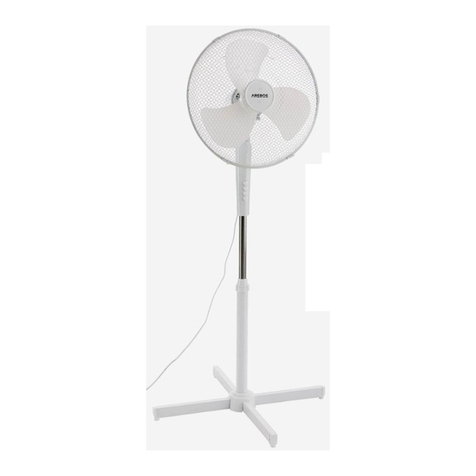
AREBOS
AREBOS AR-HE-SV1645W user manual
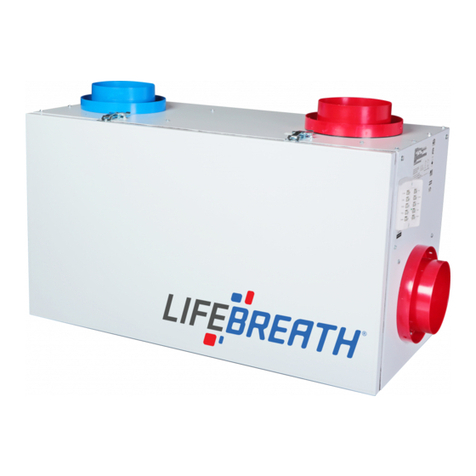
Lifebreath
Lifebreath RNC series installation guide

Rockford Chimney Supply
Rockford Chimney Supply Rock-Flex AL29-4C Installation and maintenance instructions
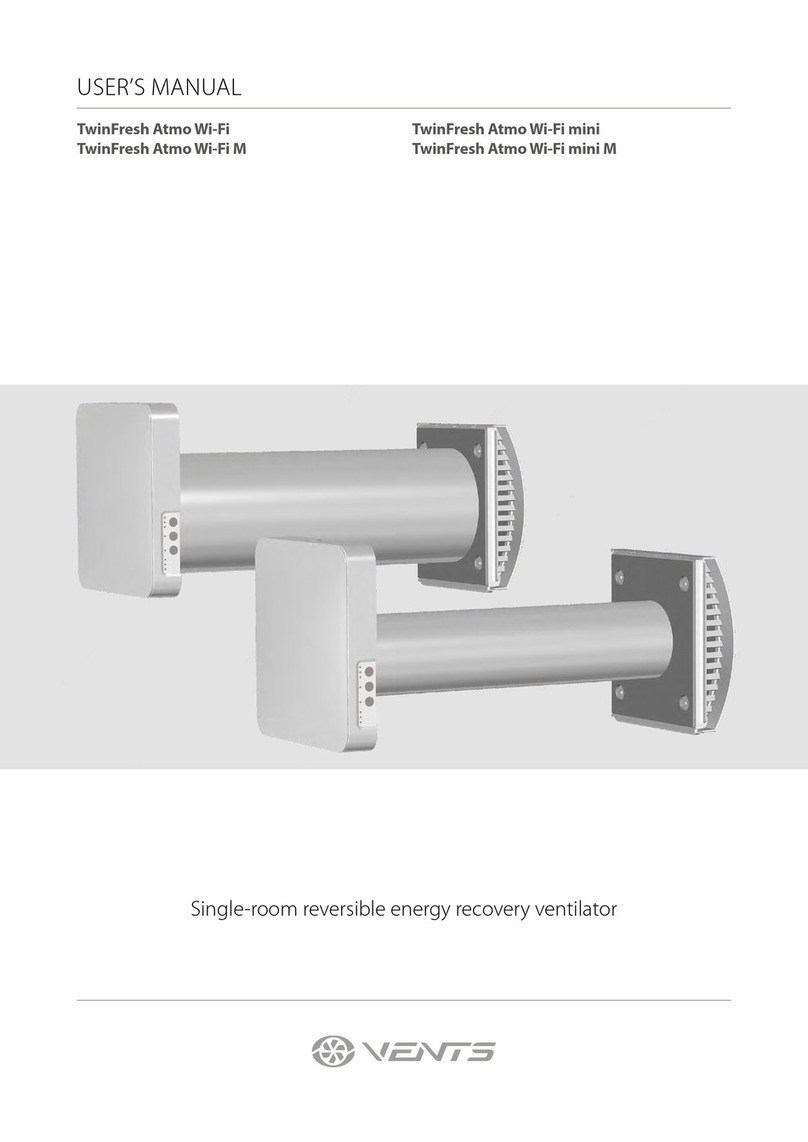
Vents
Vents TwinFresh Atmo Wi-Fi user manual

Teka
Teka ECO-Cube operating instructions
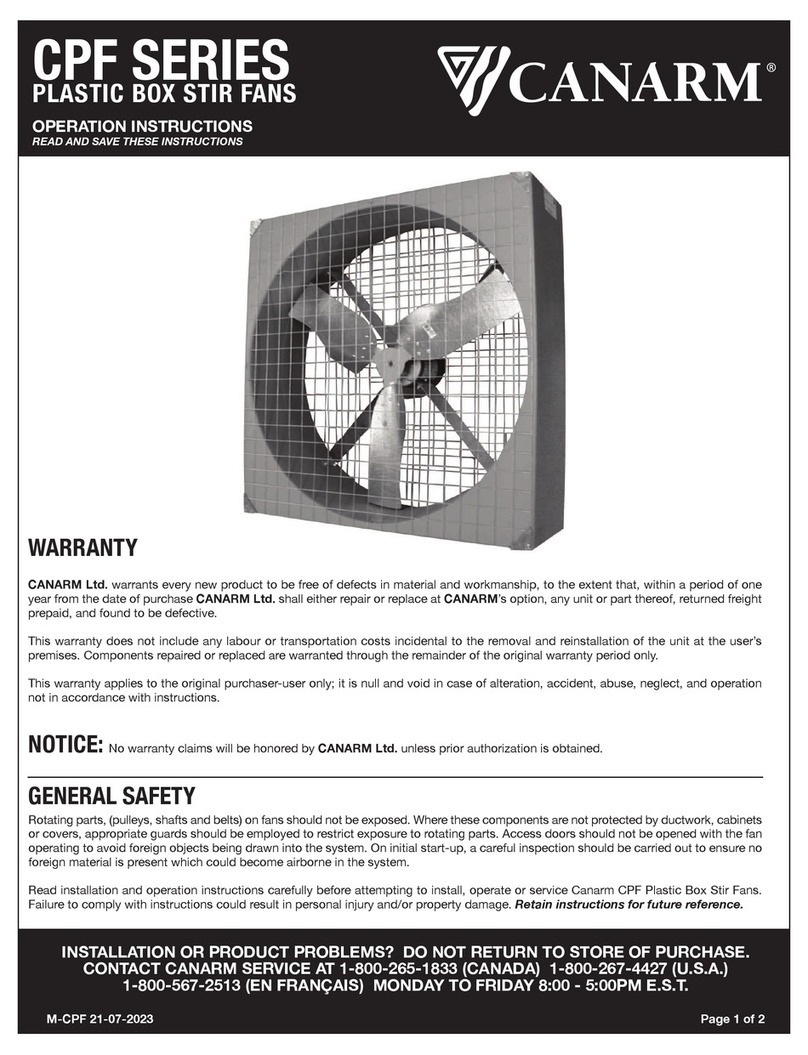
Canarm
Canarm CPF Series Operation instructions
